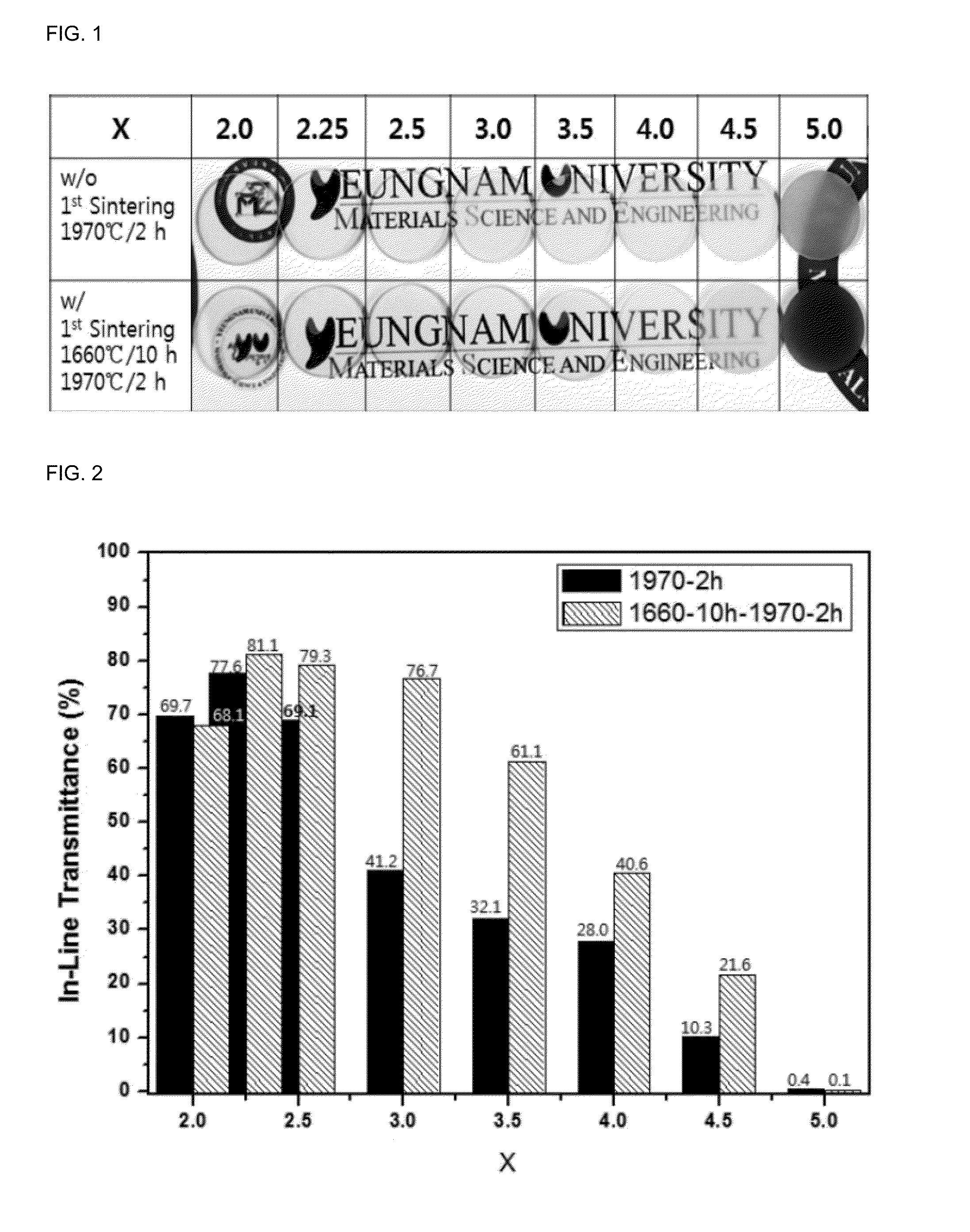Method for preparing polycrystalline aluminum oxynitride having enhanced transparency
a technology of aluminum oxynitride and polycrystalline alon, which is applied in the field of preparing polycrystalline alon having enhanced transparency, can solve the problems of difficult to prepare transparent products, high cost, and low productivity, and achieve high hardness, high wear resistance, and high intensity
- Summary
- Abstract
- Description
- Claims
- Application Information
AI Technical Summary
Benefits of technology
Problems solved by technology
Method used
Image
Examples
example 1
[0056]Aluminum oxynitride (AlON) was prepared by fixing yttrium oxide (Y2O3) and magnesium oxide (MgO) that are used as sintering additives respectively to 0.08 wt % and 0.15 wt % while varying a mole ratio of aluminum nitride (AlN) from 18.2% (x=2.0) to 35.7% (x=5.0). The actual content of aluminum oxide (Al2O3) and AlN that are two main materials were calculated based on an x value while considering the content of oxygen (about 1 wt %) contained in AlN powder due to surface oxidation and an abrasion loss of a Al2O3 ball during a ball-milling process. Such raw-material powders and sintering additives were milled in a polyurethane container for 48 hours by using a high purity Al2O3 ball by using ethylalcohol as a solvent, and then were dried by using a rotary evaporator drier. The dried powders were molded into a disk having a diameter of 20 mm and a thickness of 3 mm by using a dry uniaxial press, and then were cold isostatic pressed at 275 MPa. A specimen of the disk was sintered ...
example 2
[0063]Specimens on which only the first sintering is performed were prepared in the same manner as in Example 1, except that a temperature was varied from 1600° C. to 1725° C.
[0064]FIG. 7 is SEM images of fracture surfaces of specimens, wherein a temperature is varied from 1625° C. to 1725° C. After performing the first sintering for 10 hours, the density of the specimens is the highest at 1650° C. and the porosity of the specimens is remarkably high at 1675° C. or higher because Al2O3 and AlN react with each other to change into AlON, and AlON is slowly sintered at that temperature.
[0065]FIG. 8 is a graph of volume fractions on AlON, Al2O3, and AlN, as results of a quantitative analysis in X-ray diffraction patterns of specimens on which only first sintering is performed while varying a temperature from 1600° C. to 1725° C. An AlON phase is a main phase after 10 hours at 1650° C., and densification and phase change both occur at this temperature, and the densification is assumed to...
example 3
[0066]AlON ceramic specimens were prepared in the same manner as in Example 1, except that a temperature of first sintering was 1640° C., a duration was varied from 1 to 10 hours, and both MgO and Y2O3 or only Y2O3 was added as a sintering additive.
[0067]FIG. 9 is SEM images of minute structures of fracture surfaces after first sintering, which are changed as duration of the first sintering is varied from 1 hour to 10 hours when an x value is 2.5 and both MgO and Y2O3 are added. When the duration was short, porosity was high, and a relative density continuously increased up to 10 hours. Accordingly, in order to obtain a high relative density 10 hours need to be maintained at the temperature of the first sintering.
[0068]FIG. 10 is a graph showing an in-line transmittance of a light having a wavelength of 632 nm, which changes according to duration of first sintering, based on an x value s and based on whether MgO is added as a sintering additive. Specimens including MgO and Y2O3 alwa...
PUM
| Property | Measurement | Unit |
|---|---|---|
| temperature | aaaaa | aaaaa |
| temperature | aaaaa | aaaaa |
| visible-light transmittance | aaaaa | aaaaa |
Abstract
Description
Claims
Application Information
 Login to View More
Login to View More - R&D
- Intellectual Property
- Life Sciences
- Materials
- Tech Scout
- Unparalleled Data Quality
- Higher Quality Content
- 60% Fewer Hallucinations
Browse by: Latest US Patents, China's latest patents, Technical Efficacy Thesaurus, Application Domain, Technology Topic, Popular Technical Reports.
© 2025 PatSnap. All rights reserved.Legal|Privacy policy|Modern Slavery Act Transparency Statement|Sitemap|About US| Contact US: help@patsnap.com



